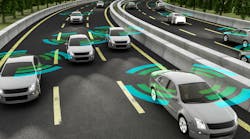The National Highway Traffic Safety Administration (NHTSA) thought the final decision had been made: The Dedicated Short Range Communications (DSRC) standard would be the official wireless technology for use in vehicle-to-vehicle (V2V) communications, as defined by the Intelligent Transportation Systems (ITS) program. V2V lets vehicles communicate with one another to improve safety, especially with respect to collision avoidance.
Now, however, that decision seems to be up in the air, with industry heavyweights putting forth cellular standards as an alternative. Since there has been no complete adoption of DSRC, it appears that there is time to reconsider the options. This technology is vital not only to the continuous improvements in advanced driver assistance systems (ADAS), but also in making the forthcoming self-driving cars as safe as possible.
DSRC Overview
DSRC V2V is a Wi-Fi variant and defined by the IEEE 802.11p standard. The FCC allocated 75 MHz of spectrum (5.85-5.925 GHz) specifically for DSRC. That spectrum is divided up into seven 10 MHz channels. The standard uses 52 subcarrier OFDM to achieve a data rate of 3 to 27 Mb/s. The range is estimated to be up to about 300 meters. It is a proven reliable technology.
The DSRC system transmits a basic safety message (BSM) between vehicles. The BSM includes information such as exact vehicle location and direction of travel, speed, braking status, and some other data. The driver doesn’t see it, but the BSM provides safety warnings and could trigger action such as automatic braking or other collision avoidance maneuvers or warnings. The BSM is updated and transmitted 10 times per second.
Another proposed function of DSRC is vehicle-to-infrastructure (V2I) communications. The vehicle links up with roadside access points that can provide additional useful information such as traffic or road conditions, weather, construction and traffic light status. A vehicle-to-network (V2N) connection is also possible for other services to be determined.
The Cellular Alternative
The cellular option is known as cellular vehicle-to-everything (C-V2X). It uses existing 4G cellular standards like LTE for both V2V and V2I. The 3GPP standards for LTE provide options such as LTE Direct or device-to-device (D2D) communications that avoids going through cell sites and the network. LTE Broadcast is another variant of LTE that allows one way broadcasts to multiple users thereby facilitating V2I or V2N functions. Also, what LTE variant would be used? Are the newer LTE-M and NB-IoT low power versions fast enough? With LTE standards finalized and hardware and software available, it is tempting to change to C-V2X. A future option is 5G systems.
Pros and Cons
The good news about DSRC is that it is a tested and proven standard. It has been widely evaluated and developed. Hardware and software are available now, it’s cost effective, and most auto makers have signed up for it.
The bad news, if bad is the right term, is that 802.11p is a mature technology with little growth potential. DSRC seems to have no place to go. Variations of other Wi-Fi standards offer some possible alternatives. Other potential downsides are poor latency and potential unlicensed spectrum conflicts. Latency is transmission time that is typically less than 25 ms. Some say that isn’t a fast enough time for collision avoidance action. The spectrum conflict is an overlap of the DSRC spectrum with the upper channels of the Wi-Fi 5GHz spectrum used by 802.11a/ac/ax. Interference between the two could cause collisions or disrupt critical Wi-Fi connections.
C-V2X using LTE is also a well-developed technology with hardware and software available. It isn’t clear what spectrum would be used. Carriers have spectrum to support C-V2X, although new spectrum could be allocated. For V2I and V2N, would a network subscription be required? Also, latency is said to be much less—like, less than 5 ms. The disadvantages are probably cost of equipment and any service agreements with carriers. And, of course, what is the path from LTE to 5G? Or do the vehicle manufacturers just wait for 5G?
The NHTSA is still on the path to adopting DSRC according the notice of proposed rulemaking issued late last year. If a final decision is made in 2019, a two-year phase-in period would then occur to accommodate manufacturers’ product development cycles, making initial installations begin in 2021 with full compliance required in 2023. It may be back to the drawing board for the NHTSA if the decision is changed.
What about you? What decision would you make?

